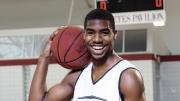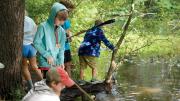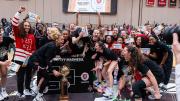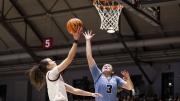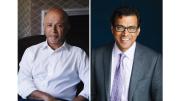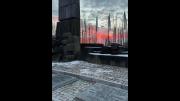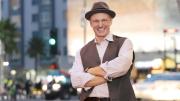Chess was the game Ed Saunders, father of Wesley Saunders ’15, recommended to his son and played with him: chess, the father said, would teach young Wes to think a few steps ahead. Apparently it worked, and not just with pawns and bishops. Last spring, in Harvard’s third-round game against Michigan State in the NCAA basketball tournament, the Spartans threw an in-bounds pass to star power forward Adreian Payne (now with the Atlanta Hawks). “I was on the help side,” Saunders recalls—the area of the court away from the ball, on defense. When the pass came to Payne, “I was able to tap the ball away from him, and out of nowhere Steve [Moundou-Missi ’15] grabs it and goes running down the sideline for a dunk. It was one of the great plays.”
Moundou-Missi’s thunderous jam over a Spartan defender narrowed the gap to 55-51 and electrified the crowd. Moments later, Saunders picked off another pass and drove the ball home to tie the game at 55. Soon, the Crimson shook the house by taking a 62-60 lead. The heavily favored Spartans eventually regrouped to prevail at the end, 80-73. But the centerpiece of that glorious Harvard run had been Saunders and his anticipation of where the throw-in might go—a skill honed at the chessboard. “The reason I am a good defender is my anticipation,” he explains. “Knowing where the pass is going to go.”
Anticipation plays a big role in many sports: it enables athletes to get the jump on the competition, sometimes quite literally. To rebound well, “you don’t need to be the highest jumper,” Saunders says. “It’s more about positioning, knowing where the ball will go when it hits off the rim.” For example, a shot from the corner, with no backboard to deflect it, typically bounces toward the opposite corner of the court.
Anticipation embraces foreknowledge of what opponents are likely to do in certain situations—or preparing for your own move by repositioning them. “Watch Dennis Rodman,” Saunders advises, naming one of the NBA’s greatest rebounders. “He would use his butt to push the defender back, and then just grab the ball. He had position.”
On offense, “I like reverse layups more than dunks,” Saunders reports. “I enjoy the finesse part of the game. When I used to play tennis, I was always doing trick shots.” He also likes spin moves, so he prefers to receive the ball in the middle of the court, where he can spin either way.
There are several types of layup: the classic layup that angles the ball off the backboard; the finger roll, in which the player rolls the ball off his fingers and over the rim. The reverse layup is probably the most stylish. To execute it, Saunders drives with the ball toward one side of the basket, and the defender “expects you to dunk, so he jumps as high as he can. Then you go under him” and lay the ball in from the other side—the “reverse” part—of the hoop. “He’s incredibly crafty,” says head coach Tommy Amaker. “Wes can move to the other side of the hoop while he’s in the air—and he’ll put English on it, too.”
Saunders has parlayed his finesse and anticipation into a bushel of points for Harvard. As a sophomore, he led the Ivy League in scoring, averaging 16.2 points per game, and last season he was Ivy League Player of the Year. He joined the Crimson’s career 1,000-point club in that Michigan State game and currently ranks thirty-first in all-time Harvard scoring, with a full season yet to play. He is so fluid and productive on offense that many underestimate his excellent defense; his 55 steals as a sophomore, for example, rank seventh in team history. “Wes is one of the best all-around players in the country,” says Amaker, “and he has been the best in our conference for some time.”
 Harvard Hardwood
Harvard Hardwood
Follow Harvard Magazine’s coverage of basketball
throughout the 2014-2015 season.
Sign up here for basketball updates via e-mail.
Though he grew up only five minutes from the L.A. Lakers’ Staples Center, Saunders has no favorite team: “I just like good basketball.” He does learn from his favorite players, like Zach Randolph of the Memphis Grizzlies, a savvy rebounder. “He never really jumps,” Saunders says. “But he knows about positioning and angles.”
Saunders grew up in a highly athletic family. His mother, Ramona Robinson, remains an excellent tennis player; his father played football at the University of Iowa, where the couple met. Uncle John Wesley Saunders played free safety for the Los Angles Rams of the National Football League and sister Akilah excelled at tennis. Wesley played basketball at Windward School in Los Angeles. “When I got there, we were very bad,” he recalls, but with his arrival and the addition of a few other talented players they won the California Interscholastic Federation championship in his sophomore and senior years. As a teenager he had to work hard to develop his outside game, because as a boy he had always been the biggest kid and so played center by default. “It slowed down my development,” he says.
He has caught up, and then some. As a Harvard freshman, Saunders played few minutes, but in the pivotal summer before sophomore year, “I worked out harder than I ever had.” (He is now a six-foot, five-inch, 215-pound shooting guard, with the strength to fight through screens.) That summer, the Crimson squad’s trip to Italy to compete against European professional teams proved another major learning experience. “You are up against players who are, arguably, more talented,” he says. “It is a different style of play. You always try to steal a little bit of somebody you come up against.”
Stealing like that serves Saunders’s major goal: becoming a fine all-around player. The sociology concentrator hopes to pursue that ambition next year in professional basketball. This winter, some pro scouts might discern a few of his underrated talents—like passing. “I don’t think people have really noticed, but I do like to pass the ball,” he says, grinning. “To find a teammate wide open, or throw up an alley-oop pass for a dunk—that feels great. The way we play, we try to get everyone to touch the ball. Everyone knows they’ll get the rock sooner or later. It raises your level of play—and it’s a lot more fun.”
